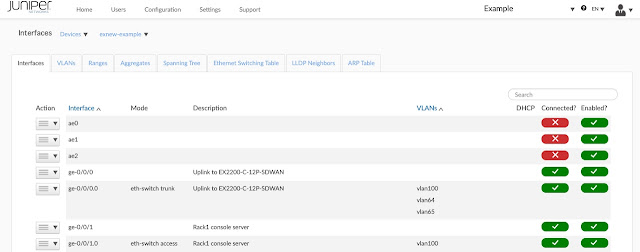Juniper software. Part 1
Intro
 |
| The Great Juniper Firewall is welcoming visitors |
This is an attempt to wade through what Juniper offers in this regards, particularly for Juniper SRX firewalls. List is probably not complete:
- J-WEB
- Junos Space
- Security Director Cloud
- ATP cloud
- Sky Enterprise
- Apstra
- Contrail
- Mist
Being heavily involved in this project Juniper & CTC I'm familiar with Mist only and had to search about the rest. Some of those above came from the Juniper Open Learning training, which by the way is a brilliant initiative. Some are used by my clients. Again the following is a very first glance just to answer those main questions:
- What are devices\application supported?
- Is it cloud \ on-prem \ hardware product?
- When the first announce was and any EOL plans?
- What is the main feature?
J-WEB. Juniper boxes built in WEB GUI.
Did not work with J-Web in the production, have a lab experience only. GUI doesn't look very intuitive, lots of menus and tabs. For system administrators managing their branch firewall without a strong CLI experience J-WEB could be a good option. Otherwise not sure what is it's value, as no features beyond CLI.
Junos Space. First attempt to build a Network Management Solution
 |
| Junos Space Network director |
- Junos Space Network Director–Enables unified management of Juniper Networks EX, QFX, QFabric, wireless LAN devices, and VMware vCenter devices in your network
- Junos Space Security Director –Allows you to secure your network by creating and publishing firewall policies, IPsec VPNs, network address translation (NAT) policies, intrusion prevention system (IPS) policies, and application firewalls
- Junos Space Services Activation Director–Collection of the following applications that facilitate automated design and provisioning of Layer 2 VPN and Layer 3 VPN services, configuration of QoS profiles, validation and monitoring of service performance, and management of synchronization
- Junos Space Service Automation–End-to-end solution designed to streamline operations and enable proactive network management for Junos OS devices.
- Junos Space Virtual Director–Enables the provisioning, bootstrapping, monitoring, and lifecycle management of a variety of Juniper virtual appliances and related virtual security solutions
- Junos Space Log Director–Enables log collection across SRX Series Firewalls and enables log visualization
Again never work with this one. Appears to be a first attempt to build an SDN by Juniper. A Security director moved to the cloud and now is part of a SASE Secure Edge. Service provisioning and automation was probably replaced with Contrail\Apstra. Eventually Mist will take them all.
Security Director Cloud. Step towards SASE
Moving forward to SASE, Juniper Secure Edge was added to a collection in 2022, offering a Secure Web Gateway, Zero Trust Network Access, etc.
Juniper ATP cloud. The Cloud Sandbox
Juniper Sky Enterprise. Catching up Meraki Dashboard
Around 2018 Sky Enterprise was announced as a comprehensive and simplified management solution for branch and small offices. It supports SRX, EX/QF campus switches, NFX appliances, centralized configuration management\backup and software management. True ZTP with new devices calling home is supported as well. Claimed to be an SDN with no Junos experience required. Multi tenancy and RBAC are also mentioned. Like the Meraki every device require a license to talk to Sky Enterprise.Unlike the Meraki, there is no Wireless solution as Juniper didn't have one at the moment. Mist Wireless monitoring was added later on, configuration is redirecting you to the Mist portal. Generally configuration appears to be device specific rather then abstracted to the site level. Tons of menus and tabs don't contribute to a simplicity. Comparing to Meraki there are much more features supported, but I would rather don't see them all at once and have an easy "Step 1-2-3" button instead.
 |
| They call it easy management |
Now the ugly. There is no SD-WAN feature in Sky Enterprise at all. Still you can create IPSec tunnels between the branches though using a wizard. There is a "Custom SD-WAN" which looks like a direct internet access with application based routing and assurance.
When with the Meraki you don't have a choice but buy a license, Juniper regular EX\SRX devices can still be configured the old way. Lack of a simple SD-WAN making Sky Enterprise even less attractive. Once Mist and 128T came to the game Sky Enterprise went to it's end even though it is still listed on Juniper web site as an SDN solution.



Comments
Post a Comment